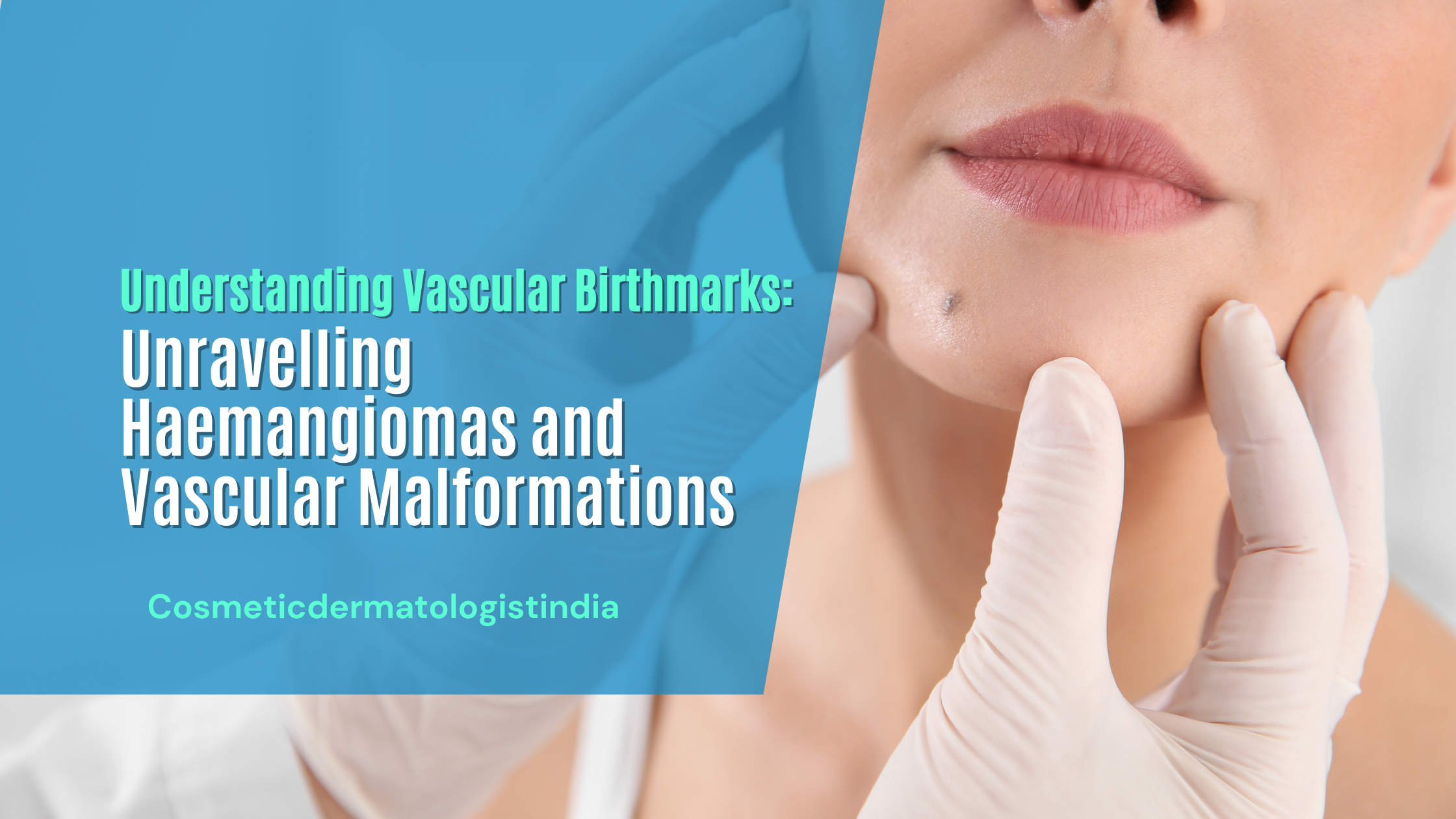
Understanding Vascular Birthmarks: Unravelling Haemangiomas and Vascular Malformations
Exploring Vascular Birthmarks
Different cultures have different implications of birthmarks, some consider the particular shape or location of birthmark to be auspicious and some consider it as a mark of beauty. There are many myths associated with birthmarks but the best dermatologist in India have a different view of birthmarks. Even passports and identification documents often use birthmarks as a mark of the identity of a person.
Medically and from a cosmetic point of view birthmarks are of different types and can appear on the baby’s body before birth or soon after it. Adults rarely get birthmarks. They can be flat or raised have defined shapes or irregular borders or differ in color such as blue, pink, red, brown, tan, or black. Most of the time birthmarks are harmless and people go through their lives without doing anything about it but in some cases, they can be problematic and even be an indicator of health problems.
This is the case, especially in vascular birthmarks. Vascular malformation and haemangiomas are two types of vascular birthmarks that are caused because of developments in blood vessels on the body that did not form as expected during fetal development.
This can be in arteries, veins, capillaries, or lymphatic vessels. Vascular birthmark removal sometimes becomes a necessity because of some underlying conditions such as nevus sebaceous syndrome, skin cancer neurofibromatosis other anomalies.
Types of vascular birthmarks
There are two types of birthmarks
- Haemangiomas
- Vascular Malformation
The correct identification and diagnosis of the birthmark help in finding the appropriate treatment plan.
Haemangioma
This is a type of vascular birthmark that appears in the form of tumors and the skin but they are non-cancerous. These birthmarks comprise of the blood vessels. They can be present at birth as a faint red mark which can easily go unnoticed, however, most appear about one to four weeks after the child’s birth.
The usual place is the head or neck area but they can appear on any part of the body including on internal organs. Haemangiomas grow rapidly for the first 12 months of their appearance and then roll bag and usually by the child turns seven the birthmark may disappear altogether.
However, if the vascular birthmark is hampering vision hearing, or breathing then a professional treatment will be necessary. Haemangiomas are more common in females than males and occur more in twins or triplets. There are four different types of haemangiomas
- Strawberry or infantile haemangiomas: these are the most common types of haemangiomas. Infantile haemangiomas are usually superficial and located on the skin surface.
- Congenital: These are usually fully formed at birthday and are further classified in two different types rapidly involuting congenital haemangiomas (RICH) that shrink quickly after birth, and non-involuting congenital haemangiomas (NICH) that remain stable and do not regress on their own.
- Deep haemangiomas: These are formed deep in the skin or on the internal organs and are often hard to diagnose and treat and can cause complications depending on their location and size.
- Segmental haemangiomas: These are large in size and are present in specific areas of the body such as a nerve distribution path.
Vascular malformations
These types of birthmarks are present at birth. They are made up of either arteries, veins, capillaries or lymphatic vessels or their combinations. They don’t have a growth cycle but they grow with the child and do not regress like haemangiomas. The common types of vascular malformations include:
- Angel kiss: These are caused because of capillary malformation and often appear on the face and are known as macular stains, salmon patches, or stork bites. They become more noticeable as the baby cries. They are sometimes butterfly-shaped.
- Port wine stains: As the name suggests, these look like somebody spilled red wine on the skin. The most common sites of appearance are the face, arms, legs, and neck. They can be of any size and as the child grows, they also grow. They can also darken over time and feel like pebbles on the skin. They don’t go away on their own and if they are near eyes then they need to be treated. They are caused because of deficient nerve supply to the blood vessels.
- Venous birthmarks: These are growing malformations that are soft to the touch and appear red. If you press them, they disappear. They are usually formed on the jaw, cheek, tongue, and lips and have low blood flow.
- Lymphatic birthmarks: These are caused when fluid accumulates in the lymphatic vessels and these are the most difficult to treat these malformations.
- Arteriovenous Malformations (AVMs): AVMs are rare and more complex than other types of malformations. They involve abnormal connections between arteries and veins without the usual capillary network between them. AVMs can cause significant complications due to high blood flow, and they often require specialized treatment.
Vascular birthmark removal
Vascular birthmark removal depends on the type of birthmark, size, location, and symptoms associated with the growth. Haemangiomas and vascular malformations are two types of abnormal growths or formations of blood vessels that can occur in the body. Here are some treatment options commonly considered for haemangiomas and vascular malformations:
Haemangiomas:
- Observation: Many infantile haemangiomas (commonly known as “strawberry marks”) don’t require treatment, as they often resolve on their own without any intervention. Regular monitoring by a healthcare professional might be recommended to ensure they’re not causing any complications.
- Medication: If haemangiomas are problematic or causing complications such as ulceration, bleeding, or obstructing vision or breathing, medications like beta-blockers (e.g., propranolol) or corticosteroids may be prescribed to help shrink the haemangioma and manage symptoms.
- Laser Therapy: Laser treatments, such as pulsed dye laser therapy, can be used to treat smaller or surface haemangiomas by targeting and shrinking the blood vessels within the lesion.
- Surgery: Surgical intervention might be considered for particularly large or problematic haemangiomas that are not responding to other treatments or are causing severe complications.
Vascular Malformations:
- Observation and Supportive Care: As with haemangiomas, some vascular malformations might not require treatment if they are not causing any symptoms or complications. Regular monitoring and supportive care might be recommended.
- Embolization: This procedure involves blocking the abnormal blood vessels by injecting a substance that causes them to clot, reducing blood flow through the malformation. It’s often used for arteriovenous malformations (AVMs).
- Sclerotherapy: Injection of a sclerosing agent into the malformation to cause scarring and shrinkage of the blood vessels. This method is commonly used for venous vascular malformations.
- Surgery: In certain cases, especially when the malformation is accessible and localized, surgical removal might be an option. However, complete removal can be challenging, especially for complex or deeply situated malformations. If the birthmark is large then it might take several sessions for complete removal of the birthmark.
- Corticosteroids: These are injected into birthmarks or can be taken orally to shrink the size of the vascular birthmark.
- Laser Therapy: Similar to haemangiomas, laser treatments can also be used for some vascular malformations such as port wine stains to help manage symptoms or improve appearance.
The choice of treatment for haemangiomas and vascular malformations is highly individualized and should be discussed with experienced and expert doctors or surgeons specializing in vascular anomalies.
They will consider the specific characteristics of the lesion, potential risks, and benefits of each treatment option before making recommendations. To remove the scarring left by surgical birthmark removal the top plastic surgeons use tissue expansion techniques to reduce the scarring.
Vascular birthmark removal cost
The birthmark removal cost in india can vary widely depending on several factors such as the type and size of the birthmark, the chosen treatment method, the condition of the skin, the location of the birthmark on the body, the clinic or hospital, the expertise of the healthcare professional, and the number of sessions required for treatment.
Treatment options for vascular birthmark removal in India may include laser therapy, surgical excision, sclerotherapy, or other specialized procedures. Each treatment method may have different associated costs. Generally, laser therapy tends to be one of the common and effective methods for removing vascular birthmarks.
It’s essential that you consult with good dermatologist in Mumbai, a plastic surgeon, or a healthcare professional specialized in treating vascular birthmarks to get a proper evaluation of the birthmark, understand the available treatment options, and receive an accurate estimate of the costs involved in the removal procedure.
Also, consider discussing any potential additional costs related to follow-up sessions, medications, post-treatment care, or consultations to ensure a complete understanding of the overall expenses involved in the vascular removal process in India.
Additionally, health insurance coverage for such procedures can vary, so it’s advisable to check with your insurance provider if any coverage applies to birthmark removal treatments.






